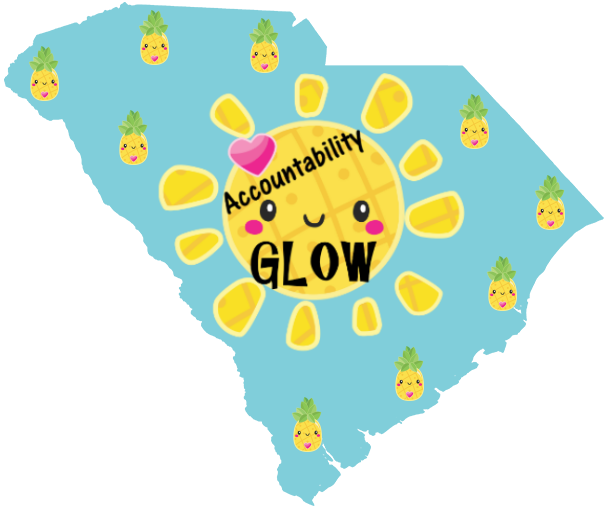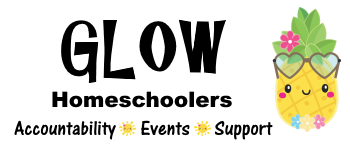

Homeschool Documentation
South Carolina option 3 requires you to keep 3 types of documentation for your homeschooled students.
You can also find examples of activities that count as school at the bottom of this page.
GLOW Accountability members can see samples of real journals and plan books and progress reports.
Journal or Plan Book – A daily log
The journal or plan book is the daily documentation for your homeschooler. It looks like a dated journal or calendar and records how many school days you have done and what subjects were covered. Which method you choose depends on your personal style. It needs to include:
- Dates for each entry
- What you did for each educational day
- Student’s name if you have more than 1
- optional – photos
A plan book is used when you plan your homeschool lessons and activities ahead of time. At the end of the day or week you can make corrections so that the plan reflects what you have done in your homeschool.
A journal is a good method for families who do not plan everything in advance. On each day that involves education, you record what has been done. Lessons, activities, etc. You can write a detailed description or you can keep it brief, just a word or two.
The format of your journal or plan book can be paper or electronic. It can be a simple spiral notebook with dated entries, a student planner, a note-taking app with photos attached, an online lesson planner, etc.
Attendance
You can use your daily log to record attendance or you can use a separate record to count the days. By the end of your school year you should have at least 180 days.
If your child attended school during the school year, those days will count toward your 180 days. You can make a note in your daily log about the number of days from school. For example, if your child started the school year with 30 days in school, you can make a note on page 1 in your daily log. Then your first homeschool day will be day 31.
GLOW Accountability members can see samples of real journals and plan books.
Portfolio with samples of academic work
The portfolio contains samples of work. It does not need to be all of the student’s work. You only need one folder or small box per academic year. At a minimum you should keep samples of all the core subjects spaced throughout the year so that progress can be seen. The portfolio samples can be real or electronic photos. Just make sure you have a good backup if going electronic.
Some examples of things to put in the portfolio: worksheets, writing samples, book list, drawings, art, workbooks, print-outs from an online curriculum, certificates of completion, etc.
Semiannual Progress Report
Twice a year you need to create a progress report for your child. Once around the 90-day halfway mark, and once at the end of your academic year. The progress report should include all the core subjects and any other subjects you cover. You may include attendance or the number of education days in the half year. The format can be in paragraphs or it can look like a report card. You may use any grading system. However high school students who plan to apply for college should use the 10-point grading scale detailed in the SC Uniform Grading Policy.
The half year progress reports need to include:
- Student name
- Grade level
- School Year
- Report date
- Number of days completed in the semester
- Subjects covered. Include more detail than just the general subject.
- A grade or comment about how the student is doing in each subject. It recommended to use numeric % grades for grades 7-12.
- Include all required subjects and any extra subjects.
Grading Scale information & ideas
GLOW Accountability members can see samples of real progress reports and can download our DIY Progress report form. Members can also find high school transcripts and report cards with the GLOW seal on the Forms Page.
IEP Style Progress Report (optional)
Students who had an IEP in school or who have a learning disability that negatively impacts their educational performance can also have a homeschool IEP report. This is in addition to the required academic progress report.
The IEP style report is created by listing all the areas where the student struggles or needs extra help. Then the parent writes about the progress in that area over the past 90 days. You can see a sample in an IEP style progress report in the GLOW Documentation Samples.
Documentation Samples
GLOW Accountability members can click here for samples of documentation – plan books, journals, and progress reports. GLOW Documentation Samples
What counts as school?
Here are some examples. These may count as core subjects or as electives:
- Field trips, educational events, museums
- Art projects, art appreciation, wood working
- Music – singing, playing, appreciation, performing, attending performances
- Physical education – sports, playground, tag, trampolines
- Board games, Coding, Educational games online
- Creating – Legos, obstacle course, treasure map, cardboard box house
- Life skills – baking, typing, etiquette, party planning, new chores, grocery store
- Nature activities – identify bugs, bird watching, hiking, fishing, flower pressing, gardening
- Animal care, learning about animals
- Reading – books of interest, magazines, cereal boxes, music lyrics, library trips
- Audio books, podcasts
- Documentaries, How-To videos, online research into interesting subjects
- Writing – journals, songs, notes, signs, homemade cards, menus
- Outdoor play – fort building, hole digging, collaborative play, exploring
- Volunteer opportunities
